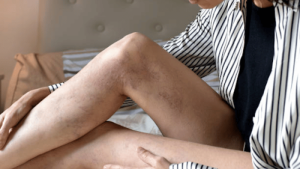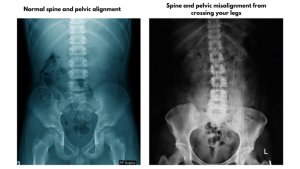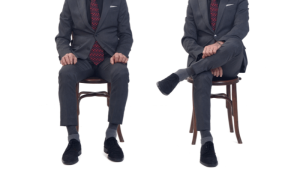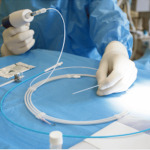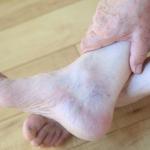
Think about all the times you’re sitting with your legs crossed — at work, on the bus, while out for dinner with friends. Have you ever noticed stiffness, tingling, or a heavy, tired feeling in the legs after sitting this way for a long time? Do you wonder if crossing your legs is bad for you?
Sitting with crossed legs is a very common position. Data even shows that the preference of crossing one leg over the other may be influenced by genetics.¹
The problem is that sitting for long periods can negatively impact your overall health, especially your veins and blood flow. Sitting with your legs crossed can also put additional pressure on your circulatory system.
Many spend long periods sitting down, often with their legs crossed. Understanding the different ways a seated posture affects the body is important. This blog explores the connections between sitting, crossing legs, and health risks and offers guidance on what to do if you notice problems with your veins.
Sign Up for Our Vein Health Newsletter
Potential Health Risks of Crossing Your Legs
Sitting still for an extended period isn’t good for you, regardless of how you sit. If your seated position keeps one leg crossed over the other, you may experience visible impacts on your nerve health, posture, and circulation.
It’s possible that sitting cross-legged can worsen conditions like varicose veins and spider veins because it can affect circulation. This overview explores how the posture of sitting with crossed legs can influence various bodily systems and potentially affect overall health.
Nerve Compression
Crossing your legs can compress some of the nerves in the legs. A study by the Journal of Korean Neurosurgical Society found that problems with the common peroneal nerve were connected to prolonged sitting cross-legged.²
This nerve supplies movement and sensation to the toes, feet, and lower leg. When it’s compressed, you might notice issues such as tingling in the lower extremities, temporary numbness, weakness in the ankles and feet, and limited mobility.
Posture Problems
Sitting with crossed legs puts the body in an asymmetrical position; habitual sitting with the legs crossed can affect posture. Studies indicate that crossing one leg over another while sitting for over three hours a day can cause hip and shoulder misalignment.³ This misalignment can also result in a back pelvic tilt, where the pelvis tilts to one side, potentially causing discomfort in the lower back and hips.
There’s also a tendency to hold the head slightly forward after sitting with legs crossed for long periods, a condition known as forward head position. This condition can cause neck pain, stiffness, and an unbalanced gait.
In addition to these concerns, sitting with crossed legs has been linked to back pain due to the uneven distribution of weight and strain on the lower back muscles. Over time, these factors can exacerbate discomfort and lead to more significant musculoskeletal problems.
Circulatory Issues
When you sit for extended periods, you may notice that your feet, legs, or buttocks begin to tingle. You may experience this sensation as “pins and needles.” In some situations, these regions may become completely numb. This type of tingling and numbness occurs because of constricted blood flow to these body areas.
A constant supply of blood is key to keeping the body healthy. Circulation issues caused by constricted blood flow can impact the body’s immune functioning, including brain, heart, and vein health.
Blood Pressure
Crossing the legs inhibits blood flow in the veins, slowing down the circulation movement back to the heart. This constriction in the leg veins can increase blood pressure. Researchers have found that people tend to have higher blood pressure if their blood pressure is taken after crossing one leg over another.4
While this effect goes away when the legs are uncrossed, keeping blood pressure elevated for a long period of time can damage the blood vessels and increase the risk of various health problems.
Blood Clots
It’s well-known that a sedentary lifestyle can negatively impact vein health and increase the risk of developing a dangerous blood clot, such as deep vein thrombosis (DVT) or a pulmonary embolism.5
Sitting in a cramped position for long periods, such as on an airplane, can increase the risk of a blood clot forming in the veins.6 Although crossing the legs can restrict blood flow, the specific relationship between crossed legs and blood clot formation has not been definitively tested. The occurrence of a blood clot could be heightened when combined with prolonged sitting in cramped conditions and crossed legs.
To reduce the risk, avoiding crossing your legs during extended periods of sitting is advisable, especially in situations where movement is limited.7
TAKE OUR FREE VEIN HEALTH SYMPTOM QUIZ
Crossing Legs and Varicose Veins: Myth and Fact
Is crossing your legs harmful to your veins? This common belief is often linked to the risks of prolonged sitting.
However, crossing your legs doesn’t cause varicose veins. Family history, age, and lifestyle factors like being overweight and lack of exercise are usually the cause of vein disease, the underlying condition that causes varicose veins.
However, sitting this way for prolonged periods can exacerbate the underlying cause of varicose and spider veins. It slows down blood circulation and increases blood pressure in the leg veins, which can damage the valves in these blood vessels.
Once the valves become weakened or damaged, blood starts flowing backward, pooling in the legs and stretching vein walls, leading to twisted, bulging leg veins.
When to See a Vein Specialist
If you have discomfort, numbness, and other vein symptoms after crossing your legs or sitting for long periods, these may be signs of underlying vein damage. Some symptoms may include cramping, swelling, and heaviness in the legs.
Once your veins are damaged, they won’t get better on their own. If left untreated, symptoms can worsen, with some people experiencing throbbing leg pain, leg ulcers, and severe varicose veins. However, non-surgical vein treatments can target problematic veins, helping ease symptoms, reduce visible veins’ appearance, and support overall vein health.
Take our vein symptom quiz to learn more about when leg pain, heaviness, and other symptoms are signs that you should see a vein specialist.
The experienced team of doctors at USA Vein Clinics is dedicated to helping you achieve optimal vein health. Let us help evaluate your condition and create a personalized treatment plan tailored to your specific needs. Book a consultation at a vein center near you today.
Frequently Asked Questions
What are the side effects of crossing your legs?
Sitting with the legs crossed can compress specific nerves in your legs and reduce circulation, causing numbness and tingling in the feet and lower legs.
Can crossing legs cause varicose or spider veins?
You can’t get varicose or spider veins from crossing your legs. The external pressure from leg crossing does not damage the small blood vessels in your legs, as genetic factors, hormonal changes, or prolonged standing or sitting primarily cause varicose veins. Additionally, varicose veins occur when valves in the veins malfunction, leading to blood pooling, which isn’t influenced by crossing your legs.
Why should you uncross your legs when taking blood pressure?
Crossing your legs can compress leg veins, artificially raising your blood pressure reading and causing temporary spikes that may not reflect your true baseline levels. This can lead to inaccurate measurements and potentially affect your initial diagnosis and healthcare decisions. For accurate results, sitting with your feet flat on the floor and your legs uncrossed during a blood pressure check is recommended.
Is crossing your legs bad for circulation?
Crossing your legs isn’t good for circulation. It makes it harder for your veins to pump blood back to the heart and can contribute to inflammation and weakening of the veins, which, over time, may increase the risk of developing circulatory problems. Prolonged leg crossing can also lead to numbness and discomfort due to restricted blood flow. To promote better circulation, it is recommended that you avoid crossing your legs for extended periods and take breaks to move around regularly.
MORE QUESTIONS? TALK TO A VEIN SPECIALIST TODAY
Sources
- Michael Reiβ, “Leg-crossing: incidence and inheritance,” Neuropsychologia, https://doi.org/10.1016/0028-3932(94)90034-5
- Jeong Keun Yu, Jin Seo Yang, Suk-Hyung Kang, and Yong-Jun Cho, “Clinical characteristics of peroneal nerve palsy by posture,” Journal of Korean Neurosurgical Society, https://doi.org/10.3340/jkns.2013.53.5.269
- Yongnam Park and Youngsook Bae, “Comparison of postures according to sitting time with the leg crossed,” Journal of Physical Therapy Science, https://doi.org/10.1589/jpts.26.1749
- Rukiye Pinar, Siddika Ataalkin, and Roger Watson, “The effect of crossing legs on blood pressure in hypertensive patients,” Journal of Clinical Nursing, https://doi.org/10.1111/j.1365-2702.2009.03148.x
- Christopher Kabrhel, Raphaëlle Varraso, Samuel Z Goldhaber, Eric Rimm, and Carlos A Camargo, Jr, “Physical inactivity and idiopathic pulmonary embolism in women: Prospective study,” BMJ https://doi.org/10.1136/bmj.d3867
- Poul Suadicani, Harald Hannerz, Elsa Bach, Finn Gyntelberg, “Jobs encompassing prolonged sitting in cramped positions and risk of venous thromboembolism: Cohort study,” JRSM Short Reports, https://doi.org/10.1258/shorts.2011.011121
- Heidi Godman, “Top causes of blood clots in the legs and how to avoid them,” Harvard Health Publishing. https://www.health.harvard.edu/staying-healthy/top-causes-of-blood-clots-in-the-legs-and-how-to-avoid-them

